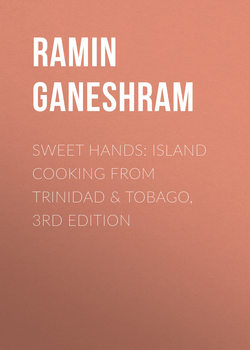Читать книгу Sweet Hands: Island Cooking from Trinidad & Tobago, 3rd edition - Ramin Ganeshram - Страница 34
На сайте Литреса книга снята с продажи.
ОглавлениеOne of my greatest pleasures on trips back to Trinidad is the first taste of doubles the morning after I arrive. Spiced chickpeas with onions and pepper sauce folded between rounds of fried bread, doubles are Trinidad’s equivalent of a New York bagel purchased at a coffee truck. Doubles do double-duty, however, as a wee hours snack for late night clubbers. In fact, the only way to eat them is from the various stands on the side of the road, and everyone has their favorite. I like the ones sold inside Brooklyn Bar in Woodbrook, one of the few remaining old-style rum shops in Trinidad. My husband Jean-Paul swears, as does our good friend Gerard Ramsawak, that Curepe is the only place for any kind of decent doubles.
Food stands are a tradition in Trinidad, probably dating back to times when day laborers on sugar and cocoa estates had nowhere else to procure a hot midday meal. Today, vendors dot the country, hawking fried oysters, roti, kacheena, shark & bake, beef patties, shaved ices, spiced roasted peanuts, as well as gyros, sold by recent waves of Syrian immigrants to the island. Every one of them has their followers. The more elegant stands may have a table or two, while others cook the food ahead of time and sell it out of galvanized metal or plywood shacks. In my experience, the best street-food vendors operate out of trucks similar to the hot dog trucks that we find at beachfronts in the U.S. The food is cooked or reheated on site, so the meal is hot and tasty.
Perhaps the most famous iteration of the Trinidad food stand was the Breakfast Shed, an old warehouse building on Port of Spain’s waterfront. It began in 1926 under the auspices of Audrey Jeffers, a philanthropist who started the venture as a way to provide lunches to poorer schoolchildren. In Port of Spain, the tradition, lore, and local patronage of this eatery is not unlike that of New York’s Nathan’s Famous or New Orleans’ Café du Monde. The Breakfast Shed offered traditional home-style breakfast and lunch to schoolchildren, dockworkers, and political types working in the city center. Cruise-ship travelers eventually joined the mix and the place became a “must-see” pit stop for tourists hoping to savor a taste of the real Trinidad. For a time, newfound tourism fame resulted in a facelift for the old Breakfast Shed, and it was housed in a bright yellow concrete building plastered with packaged food ads, far different from the old galvanized shed I remembered as a child. In 2007-2008, the waterfront area where Breakfast Shed stood was redeveloped with an ultramodern promenade, complete with an elaborate fountain and the luxury Hyatt Regency Hotel a few hundred yards away. A clean, bright new building called the Femmes De Chalet now houses the old Breakfast Shed vendors and the food is as good as ever, but it sure feels odd to go back “home” and not get a meal in the colorful cacophony that was the old establishment.
Visitors who want to sample a large array of street food in one locale should head to the Queen’s Park Savannah in Port of Spain. Vendors have set up shop around the perimeter to serve the constant flow of walkers, joggers, and event-goers in the large park, although the government is trying to monitor and crack down on street-food vending. A new and popular street-food event at the Savannah is nighttime food truck gatherings. Port of Spain residents have been known to hit the stands and set up picnic blankets or chairs and small tables on the grass and eat under the stars.
Soups are also among the food traditionally eaten out, and stands selling cow heel soup or sancoche (a classic Caribbean stew) abound.
In the home, appetizers don’t really exist as a separate course in the traditional sense, but small self-contained foods that are eaten as snacks at breakfast or teatime make wonderful starters for the American table.
